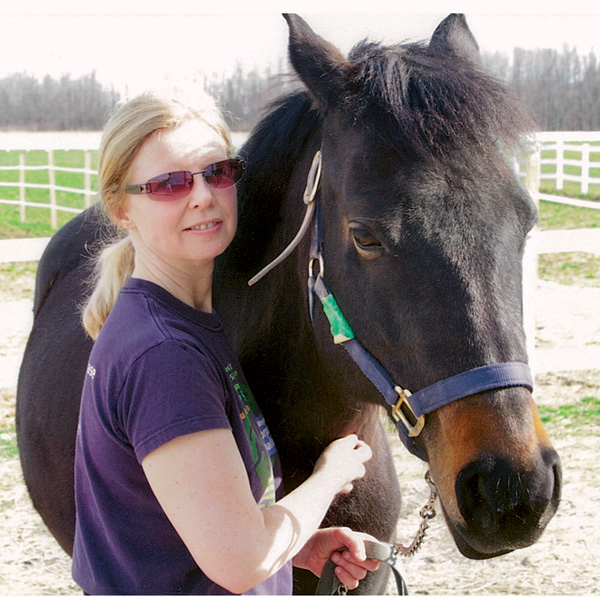Maybe it was the brutal Buffalo winter, or the fact that my riding had fallen into a rut. Either way, March of 2014 found me in sunny Florida, participating in a four-day Western dressage clinic. Lynn Palm and Cyril Pittion-Rossillon presented the clinic at their beautiful Fox Grove Farm in Ocala. It was quite an experience.

Day 1: Quivery Muscles
On the first morning, clinic participants gathered around Lynn and Cyril’s kitchen table for introductions and our initial lecture—the theory behind the rider’s position and the horse’s balance. We then adjourned to the barn to meet our assigned horses.
Mine was Alec, a 16-year-old gelding sired by world-famous Rugged Lark, member of the American Quarter Horse Association’s Hall of Fame. I would grow quite attached to Alec over the next few days.
After tacking up, we assembled in the covered arena. There, Cyril put us through a progression of increasingly torturous exercises designed to deepen our seats and improve our balance in the saddle. I actually could feel my balance changing with each exercise.
By the time we adjourned for lunch, however, my legs and abdominal muscles were shaking with exhaustion. Pleased with my efforts, I was ready to call it a day. A review of the schedule indicated otherwise. The day had barely begun!
After enjoying the home-cooked lunch Lynn prepared for us, we reconvened for a discussion on the bending and turning aids. Easy-peasy—or so I thought until we saddled up for the second time that day and practiced our turns under Lynn’s sharp eye.
Try as I might, I could not bend Alec through the corner. When I was ready to give up, Lynn planted herself what seemed a hair’s width from the corner of the arena and demanded that I guide Alec between her and the wall.
Finally, success! By using the appropriate rein and leg aids, I could indeed bend Alec through the corner, then arc him into a serpentine.
Happy and exhausted, we untacked, cleaned up, and headed back to Lynn and Cyril’s home for cocktails and a delightful dinner.
Days 2 and 3: Inspiration
The daily regimen continued to include morning and afternoon lectures, plus two riding lessons where we worked to put the lectures’ theories into practice.
On the afternoon of day three, we watched Lynn ride a Western dressage test on Larks Home Run, another Rugged Lark son. The evident harmony between them was moving and motivating. Because Lynn and Cyril make every experience a teaching moment, Cyril approached individual participants to point out some relevant thing Lynn was doing that might be helpful to that particular student.
The day ended with dinner and a bonfire. Lynn and her associate Marie-Frances entertained us with hilarious stories about their experiences at some of the many clinics and expos they’ve attended over the years.
Day 4 and Beyond
I was nervous about riding my first Western dressage test, but participation wasn’t optional.
“What’s the most important thing to remember?” Cyril quizzed us as he assigned us our tests at breakfast. We reviewed our notes.
“Be accurate!” someone called out.
“No,” he replied.
“Relaxation?” someone else offered.
“No, that’s not it, either.”
“Balance? Smooth transitions? Keep looking up?”
No, no, no.
Finally, as we stared at him in exasperation, he told us: “Have fun.”
And, though I didn’t ride the test as well as I’d hoped, it was fun. Plus it gave me a lot to work on, as our clinicians supplied each of us with detailed individual feedback and tips for improving.
Now, ever since the clinic, I always practice with a plan, incorporating a small portion of a dressage test into each ride. My improved balance in the saddle has boosted my confidence, and I use my seat more effectively to regulate gaits and make transitions.
And, make no mistake, my riding is out of that rut.
Leah Gold lives in Buffalo, New York, with one dog, three cats, and an understanding husband. When not working or puttering in the garden, she attempts to outsmart her two Morgan mares, Raynyday Romance and Applebrook Center Stage, known collectively as “the girls.”






